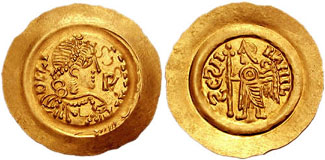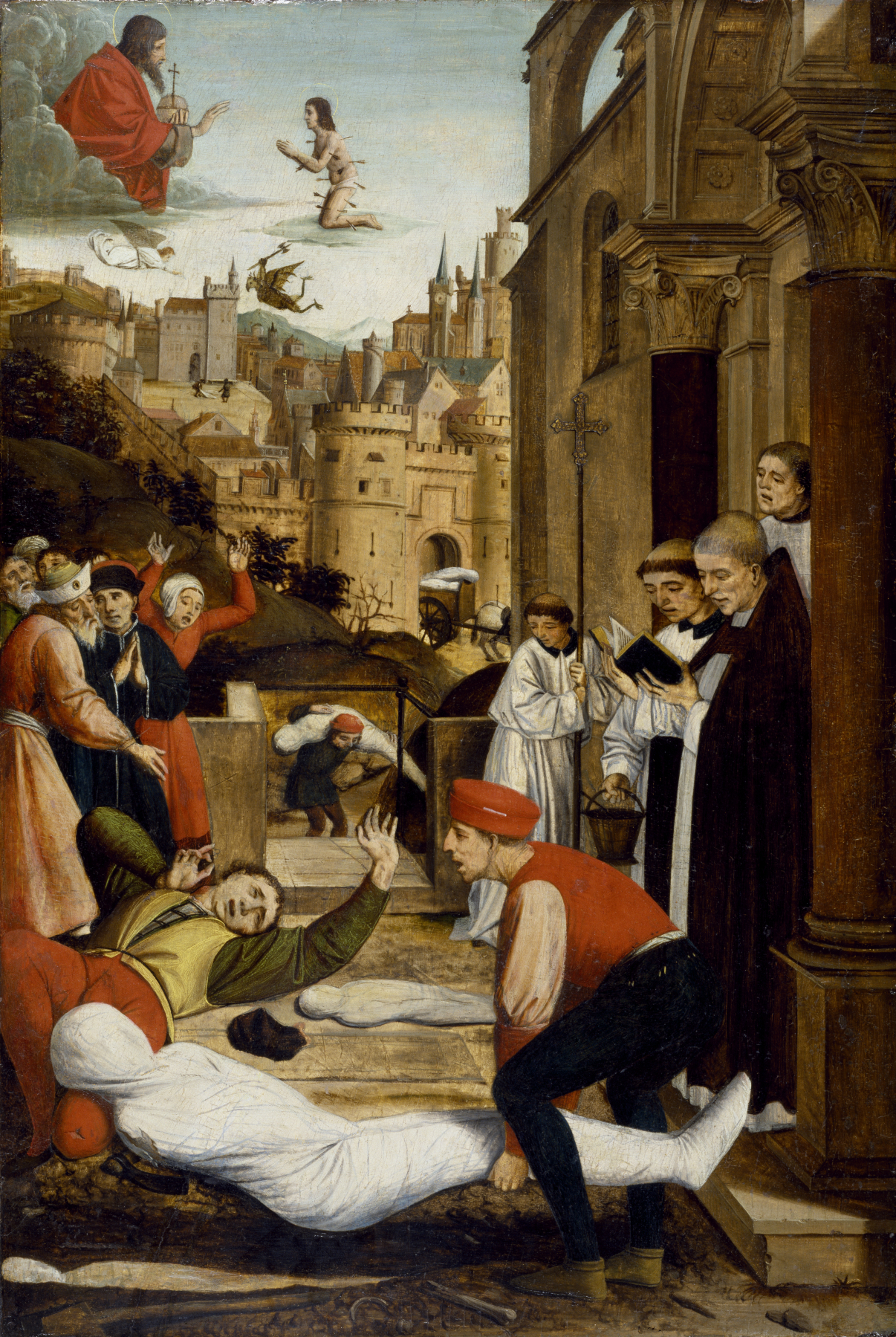|
Hildeprand
Hildeprand (died after 744), sometimes called the Useless, was the king of the Lombards from around 735 in association with his uncle, Liutprand. After Liutprand's death in 744, Hildeprand ruled in his own name until he was overthrown later that year by Ratchis, duke of Friuli. The son of Sigiprand, duke of Asti, Hildeprand was also a duke (''dux'') prior to his elevation to the throne. In 734, he participated in the successful siege of Byzantine Ravenna. Either just before or after the siege, Liutprand fell ill and was not expected to live. The leading Lombard noblemen elected Hildeprand as king, but Liutprand recovered. Although displeased with the election, he felt bound to accept Hildeprand as co-ruler. Liutprand himself had been elected while his father Ansprand, was fatally ill. In both cases, the initiative to elect a successor was taken by the nobility. By 735, the diplomacy of Pope Gregory II had patched together an alliance between the Byzantine exarch, Eutychius, ... [...More Info...] [...Related Items...] OR: [Wikipedia] [Google] [Baidu] |
Kingdom Of The Lombards
The Kingdom of the Lombards, also known as the Lombard Kingdom and later as the Kingdom of all Italy (), was an Early Middle Ages, early medieval state established by the Lombards, a Germanic people, on the Italian Peninsula in the latter part of the 6th century. The king was traditionally elected by the very highest-ranking aristocrats, the Duke (Lombard), dukes, as several attempts to establish a hereditary dynasty failed. The kingdom was subdivided into a varying number of duchies, ruled by semi-autonomous dukes, which were in turn subdivided into gastaldates at the municipal level. The capital of the kingdom and the center of its political life was Pavia in the modern northern Italian region of Lombardy. The Lombard invasion of Italy was opposed by the Byzantine Empire, which had control of the peninsula at the time of the invasion. For most of the kingdom's history, the Byzantine-ruled Exarchate of Ravenna and Duchy of Rome separated the northern Lombard duchies, collective ... [...More Info...] [...Related Items...] OR: [Wikipedia] [Google] [Baidu] |
King Of The Lombards
The kings of the Lombards or ''reges Langobardorum'' (singular ''rex Langobardorum'') were the monarchs of the Lombard people from the early 6th century until the Lombardic identity became lost in the 9th and 10th centuries. After 774, the kings were not Lombards, but Franks. From the 12th century, the votive crown and reliquary known as the Iron Crown (''Corona Ferrea'') retrospectively became a symbol of their rule, though it was never used by Lombard kings. The primary sources for the Lombard kings before the Frankish conquest are the anonymous 7th-century '' Origo Gentis Langobardorum'' and the 8th-century ''Historia Langobardorum'' of Paul the Deacon. The earliest kings (the pre-Lethings) listed in the ''Origo'' are almost certainly legendary. They purportedly reigned during the Migration Period. The first ruler attested independently of Lombard tradition is Tato. Early rulers Legendary rulers * Shava *Ybor and Agio, brothers, together with their mother Gambara, who led ... [...More Info...] [...Related Items...] OR: [Wikipedia] [Google] [Baidu] |
Liutprand, King Of The Lombards
Liutprand was the List of kings of the Lombards, king of the Lombards from 712 to 744 and is chiefly remembered for his multiple phases of law-giving, in fifteen separate sessions from 713 to 735 inclusive, and his long reign, which brought him into a series of conflicts, mostly successful, with most of Italian peninsula, Italy. He is often regarded as the most successful Lombard monarch, notable for the Donation of Sutri in 728, which was the first accolade of sovereign territory to the Papacy. Early life Liutprand's life began inauspiciously. His father was driven to exile among the Bavarians, his older brother Sigipert was blinded by Aripert II, king of the Lombards, and his mother Theodarada and sister Aurona were mutilated (their noses and ears were cut off). Liutprand was spared only because his youth made him appear harmless, described as adolescens in Paul the Deacon's ''Historia Langobardorum'' (Book VI, xxii), suggesting that he was 'probably older than 19 but still in h ... [...More Info...] [...Related Items...] OR: [Wikipedia] [Google] [Baidu] |
Ratchis
RatchisAlso spelled ''Rachis'', ''Raditschs'', ''Radics'', ''Radiks''. (died after 757) was the Duke of Friuli (739–744) and then King of the Lombards (744–749). Ratchis was the son of Duke Pemmo of Friuli and the nephew of the Lombard king Liutprand, who, despite his history of strife with Pemmo, appointed Ratchis to succeed his father in 737. Ratchis was married to a Roman woman named Tassia. During his rule of Friuli, he launched an expedition against the Slavs in Carniola, across the Eastern Alps, fighting in person during the battles. He became king of the Lombards in 744, after the deposition of Hildeprand, most likely with the support of the more autonomous Lombard dukes. Ratchis ruled initially in peace, in particular with the neighboring Byzantine-ruled exarchate of Ravenna. However, perhaps pushed by more traditional parties among his followers, in 749 he invaded the Duchy of the Pentapolis and besieged Perugia. Pope Zachary convinced him to lift the siege, bu ... [...More Info...] [...Related Items...] OR: [Wikipedia] [Google] [Baidu] |
List Of Kings Of The Lombards
The kings of the Lombards or ''reges Langobardorum'' (singular ''rex Langobardorum'') were the monarchs of the Lombard people from the early 6th century until the Lombardic identity became lost in the 9th and 10th centuries. After 774, the kings were not Lombards, but Franks. From the 12th century, the votive crown and reliquary known as the Iron Crown (''Corona Ferrea'') retrospectively became a symbol of their rule, though it was never used by Lombard kings. The primary sources for the Lombard kings before the Frankish conquest are the anonymous 7th-century '' Origo Gentis Langobardorum'' and the 8th-century ''Historia Langobardorum'' of Paul the Deacon. The earliest kings (the pre-Lethings) listed in the ''Origo'' are almost certainly legendary. They purportedly reigned during the Migration Period. The first ruler attested independently of Lombard tradition is Tato. Early rulers Legendary rulers * Shava *Ybor and Agio, brothers, together with their mother Gambara, who led ... [...More Info...] [...Related Items...] OR: [Wikipedia] [Google] [Baidu] |
Liutprand The Lombard
Liutprand was the king of the Lombards from 712 to 744 and is chiefly remembered for his multiple phases of law-giving, in fifteen separate sessions from 713 to 735 inclusive, and his long reign, which brought him into a series of conflicts, mostly successful, with most of Italy. He is often regarded as the most successful Lombard monarch, notable for the Donation of Sutri in 728, which was the first accolade of sovereign territory to the Papacy. Early life Liutprand's life began inauspiciously. His father was driven to exile among the Bavarians, his older brother Sigipert was blinded by Aripert II, king of the Lombards, and his mother Theodarada and sister Aurona were mutilated (their noses and ears were cut off). Liutprand was spared only because his youth made him appear harmless, described as adolescens in Paul the Deacon's ''Historia Langobardorum'' (Book VI, xxii), suggesting that he was 'probably older than 19 but still in his twenties'. He was released from Aripert II's c ... [...More Info...] [...Related Items...] OR: [Wikipedia] [Google] [Baidu] |
Chronicon Venetum
The ''Chronicon Venetum et Gradense'', formerly known as the ''Chronicon Sagornini'', is a Venetian chronicle compiled by John the Deacon in ca. 1008. It is the oldest chronicle of the Republic of Venice. John was the chaplain and perhaps a relative of Venetian Doge Pietro II Orseolo Pietro II Orseolo (961−1009) was the Doge of Venice from 991 to 1009, and a member of the House of Orseolo. He began the period of eastern expansion of Venice that lasted for the better part of 500 years. He secured his influence in the Dalma ... (r. 991–1009). The first part, dealing with early history, is lacking, only later becoming more accurate, and in the time of John himself deemed particularly valuable. It details the reign of Pietro II. References Sources *{{cite book, last=Herbermann, first=Charles George, title=The Catholic Encyclopedia, url=https://books.google.com/books?id=R1HTvhNblQUC, year=1950, publisher=Appleton, page=491 1008 works Medieval historical texts in Latin C ... [...More Info...] [...Related Items...] OR: [Wikipedia] [Google] [Baidu] |
Lombard Warriors
The term Lombard refers to people or things related to Lombardy, a region in northern Italy. History and culture * Lombards, a Germanic tribe * Lombardic language, the Germanic language spoken by the Lombards * Lombards of Sicily, a linguistic minority living in Sicily, southern Italy * Lombard League, a medieval alliance of some 30 cities in Northern Italy * Lombard language, a Gallo-Italic language spoken in Northern Italy and southern Switzerland ** Old Lombard, the form of the Lombard language from the 13th and 14th centuries * Lombardic capitals, a decorative lettering style originally used in medieval manuscripts Businesses * ICICI Lombard, an insurance company in India * Le Lombard (or Editions Lombard), a Belgian comic book publisher * Lombard Bank, a bank in Malta * Lombard North Central, a finance house in the United Kingdom Places ;France * Lombard, Doubs, a commune of the Doubs ''département'' * Lombard, Jura, a commune of the Jura ''département'' ;Unite ... [...More Info...] [...Related Items...] OR: [Wikipedia] [Google] [Baidu] |
8th-century Lombard Monarchs
The 8th century is the period from 701 (represented by the Roman numerals DCCI) through 800 (DCCC) in accordance with the Julian Calendar. In the historiography of Europe the phrase the long 8th century is sometimes used to refer to the period of circa AD 660–820. The coast of North Africa and the Iberian Peninsula quickly came under Islamic Arab domination. The westward expansion of the Umayyad Empire was famously halted at the siege of Constantinople by the Byzantine Empire and the Battle of Tours by the Franks. The tide of Arab conquest came to an end in the middle of the 8th century.Roberts, J., '' History of the World'', Penguin, 1994. In Europe, late in the century, the Vikings, seafaring peoples from Scandinavia, begin raiding the coasts of Europe and the Mediterranean, and go on to found several important kingdoms. In Asia, the Pala Empire is founded in Bengal. The Tang dynasty reaches its pinnacle under Chinese Emperor Xuanzong. The Nara period begins in J ... [...More Info...] [...Related Items...] OR: [Wikipedia] [Google] [Baidu] |
Pope Zachary
Pope Zachary (; 679 – March 752) was the bishop of Rome from 28 November 741 to his death in March 752. He was the last pope of the Byzantine Papacy. Zachary built the original church of Santa Maria sopra Minerva, forbade the traffic of slaves in Rome, negotiated peace with the Lombards, and sanctioned Pepin the Short's usurpation of the Frankish throne from Childeric III. Zachary is regarded as a capable administrator and a skillful and subtle diplomat in a dangerous time. Early career Zachary was born into a family of Greek origin, in the Calabrian town of Santa Severina. He was most probably a deacon of the Roman Church and as such signed the decrees of the Roman council of 732. He was selected to succeed Gregory III as pope on 3 December or 5 December 741. Pontificate Gregory III's alliance with the Lombard Duchy of Spoleto put papal cities at risk when the dukes of Spoleto and Benevento rebelled. Zachary turned to King Liutprand the Lombard directly. Out of re ... [...More Info...] [...Related Items...] OR: [Wikipedia] [Google] [Baidu] |
Pavia
Pavia ( , ; ; ; ; ) is a town and comune of south-western Lombardy, in Northern Italy, south of Milan on the lower Ticino (river), Ticino near its confluence with the Po (river), Po. It has a population of c. 73,086. The city was a major political centre in the medieval period, being the capital of the Ostrogothic Kingdom from 540 to 553, of the Kingdom of the Lombards from 572 to 774, of the Kingdom of Italy (Holy Roman Empire), Kingdom of Italy from 774 to 1024 and seat of the Visconti of Milan, Visconti court from 1365 to 1413. Pavia is the capital of the fertile province of Pavia, which is known for a variety of agricultural products, including wine, rice, cereals, and dairy products. Although there are a number of industries located in the suburbs, these tend not to disturb the peaceful atmosphere of the town. It is home to the ancient University of Pavia (founded in 1361 and recognized in 2022 by the Times Higher Education World University Rankings, Times Higher Education ... [...More Info...] [...Related Items...] OR: [Wikipedia] [Google] [Baidu] |
Duchy Of The Pentapolis
In the Byzantine Empire, the Duchy of the Pentapolis was a duchy (Latin: ''ducatus''), a territory ruled by a duke (''dux'') appointed by and under the Exarch of Ravenna. The Pentapolis (from the Greek term ''πεντάπολις'', "five cities") consisted of the cities of Ancona, Fano, Pesaro, Rimini and Sinigaglia. It lay along the Adriatic coast between the rivers Marecchia and Misco immediately south of the core territory of the exarchate ruled directly by the exarch (the Ravennate), east of the Duchy of Perugia, another Byzantine territory, and north of the Duchy of Spoleto, which was part of the Lombard Kingdom of Italy (founded in 568). The duchy probably extended inland as far as the Apennine Mountains, perhaps beyond, and its southernmost town was Humana (Numera) on the northern bank of the Misco. The capital of the Pentapolis was Rimini and the duke was both the civil and military authority in the duchy. The Pentapolis was one of the more commercially vibrant part ... [...More Info...] [...Related Items...] OR: [Wikipedia] [Google] [Baidu] |




